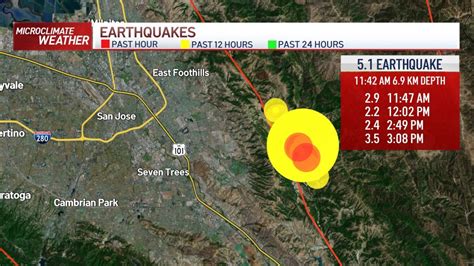5.1 Magnitude Quake: Aftershocks Predicted – What You Need to Know
A 5.1 magnitude earthquake is a significant event that can cause considerable damage and disruption. While the initial quake is undoubtedly concerning, the possibility of aftershocks adds another layer of uncertainty and potential danger. Understanding what to expect and how to prepare is crucial for both immediate safety and long-term resilience. This article will explore the science behind aftershocks, explain why they occur, and provide practical steps to prepare for and mitigate the risks associated with them.
Understanding Aftershocks: The Science Behind Them
Aftershocks are smaller earthquakes that follow a larger earthquake, or mainshock, in the same region. They occur because the initial rupture of the Earth's crust alters the stress distribution in surrounding areas. This creates new points of weakness, leading to further adjustments and seismic activity. The frequency and intensity of aftershocks decrease over time, following a pattern often described as an Omori law decay. However, significant aftershocks can still occur days, weeks, or even months after the mainshock.
Key factors influencing aftershock frequency and magnitude:
- Magnitude of the mainshock: Larger mainshocks generally produce more and stronger aftershocks.
- Geological setting: The specific geological characteristics of the region influence the likelihood and intensity of aftershocks.
- Fault geometry: The shape and complexity of the fault line affect the distribution of stress and the potential for aftershocks.
Predicting Aftershocks: Challenges and Probabilities
While precise prediction of aftershocks is currently impossible, scientists can estimate the probability of their occurrence based on historical data and the characteristics of the mainshock. This involves statistical models that take into account the size of the mainshock and the rate of decay of aftershocks observed in similar events. These models provide probabilistic forecasts, not deterministic predictions, meaning they give the likelihood of an aftershock of a certain magnitude within a specified timeframe.
Limitations of aftershock prediction:
- Complexity of geological systems: The Earth's crust is incredibly complex, making precise modeling of stress changes extremely challenging.
- Data limitations: Although seismological data has improved significantly, gaps in historical records can affect the accuracy of probabilistic models.
- Unpredictable factors: Unforeseen geological factors can influence aftershock activity, making predictions less accurate.
Preparing for Aftershocks: A Practical Guide
Regardless of the ability to precisely predict aftershocks, preparedness is crucial. The following steps can significantly reduce risks and enhance your ability to cope with aftershocks:
Immediate Actions After the Mainshock:
- Check for injuries: Prioritize providing first aid to anyone injured.
- Secure your surroundings: Turn off utilities if necessary and avoid damaged areas.
- Stay informed: Monitor news reports and official emergency services for updates.
Long-Term Preparedness:
- Develop an emergency plan: Include meeting points, communication strategies, and essential supplies.
- Secure heavy objects: Anchor shelves and secure potential hazards that could fall during an aftershock.
- Stockpile emergency supplies: This should include water, food, medications, first-aid kit, and a radio.
- Learn basic first aid: Knowing how to respond to injuries can be invaluable in the event of an aftershock.
- Strengthen your home: Consider structural improvements to make your house more resilient to earthquake damage.
Conclusion: Staying Informed and Prepared
The 5.1 magnitude quake and the predicted aftershocks highlight the importance of understanding earthquake hazards and preparing accordingly. While we cannot predict aftershocks with certainty, we can significantly reduce the risks through proactive measures and informed decision-making. By combining scientific understanding with practical preparedness, communities can increase their resilience and minimize the impact of earthquakes and their aftershocks. Remember, preparation is key to mitigating the risks associated with these powerful events.
